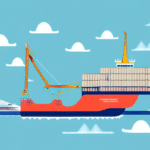If you are involved in the logistics industry, you may have heard the term O.B. Shipping Point. But what exactly does it mean? In this article, we will delve deeper into the world of shipping points, understand the role O.B. Shipping Point plays in the shipping process, explore its advantages and disadvantages within your supply chain, and offer tips on how to effectively manage your O.B. Shipping Point operations.
Understanding the Basics of Shipping Points
Shipping points refer to the physical locations where goods are loaded onto carriers for transportation. These points can vary based on the type of shipment and the transportation method utilized. For instance, shipping points for ground transportation may differ significantly from those used for air freight.
Key concepts to consider regarding shipping points include:
- Title Transfer: The shipping point is where the title to the goods transfers from the seller to the buyer. This implies that the seller retains responsibility for the goods until they are loaded onto the carrier at the shipping point.
- Transportation Costs: The designated shipping point determines who bears the transportation costs. If the shipping point is the seller's location, the seller covers the transportation costs. Conversely, if it's the buyer's location, the buyer is responsible.
- Delivery Timing: The proximity of the shipping point to the buyer's location can influence delivery times. Closer shipping points typically result in shorter delivery times, while distant ones may lead to delays.
Additionally, carriers may have specific requirements for shipping points, such as adequate loading docks or specialized equipment, to ensure the safe and efficient transportation of goods. According to the Bureau of Transportation Statistics, optimizing shipping point locations can lead to significant cost savings and improved delivery times.
O.B. Shipping Point Explained
What Does O.B. Stand For?
O.B. stands for Origin Billing. In the context of shipping, O.B. Shipping Point indicates that the shipper (typically the seller or supplier) is responsible for arranging and paying for transportation from the shipping point to the destination. The title to the goods transfers from the seller to the buyer at the shipping point, but the seller remains accountable for transportation costs.
Advantages of O.B. Shipping Point
- Greater Control: Sellers have increased control over the shipping process, allowing them to select preferred carriers and ensure quality service.
- Simplified Logistics for Buyers: Buyers who may lack the infrastructure or expertise to manage transportation logistics benefit as the seller handles these arrangements.
- Consistency: Using a preferred carrier can lead to more consistent shipping times and reliability.
Disadvantages of O.B. Shipping Point
- Higher Costs: Sellers may incur higher transportation costs, especially if they are unable to negotiate the best rates.
- Carrier Reliability: If the selected carrier is unreliable, it can lead to delays or damaged goods, affecting the buyer's satisfaction.
- Responsibility for Issues: Sellers remain responsible for transportation issues, which can strain resources if problems arise.
Differentiating O.B. from F.O.B. Shipping Points
It's essential to distinguish between O.B. Shipping Point and F.O.B. Shipping Point. While O.B. stands for Origin Billing, F.O.B. stands for Free On Board.
- O.B. Shipping Point: The seller handles and pays for transportation from the shipping point to the destination. The title transfers at the shipping point.
- F.O.B. Shipping Point: The buyer is responsible for arranging and paying for transportation from the shipping point to the destination. The title transfers when goods are loaded onto the carrier.
Understanding the difference between these terms is crucial for negotiating contracts and managing logistics effectively. For more detailed insights, refer to the Investopedia definition of F.O.B.
Selecting the Correct Shipping Point
Identifying the appropriate shipping point is vital for ensuring efficient and cost-effective transportation of goods. Factors to consider include:
- Mode of Transportation: Different transportation methods may require different types of shipping points.
- Shipment Size and Weight: Larger or heavier shipments may necessitate specific facilities or equipment.
- Destination Proximity: Choosing a shipping point closer to the destination can reduce transportation time and costs.
- Type of Goods: Perishable or fragile items may require specialized shipping points with appropriate handling and storage capabilities.
Additionally, consider whether O.B. Shipping Point aligns with your business model. While it offers control and convenience, it may not be suitable for all types of shipments. According to a report by Supply Chain Digital, optimizing shipping point selection can lead to a 15% reduction in overall logistics costs.
Determining If O.B. Shipping Point Is Right for Your Business
To ascertain whether O.B. Shipping Point is the optimal choice for your business, evaluate the following factors:
- Shipment Size and Frequency: Businesses that frequently ship large quantities may benefit more from O.B. Shipping Point due to economies of scale.
- Transportation Budget: Assess if your budget can accommodate the transportation costs associated with O.B. Shipping Point.
- Buyer Locations: If buyers are geographically dispersed, centralized shipping points might optimize delivery times and costs.
- Type of Goods: Perishable goods may require faster transportation methods, making O.B. Shipping Point more suitable.
For businesses shipping perishable items like fresh produce or electronics, maintaining control over the logistics process through O.B. Shipping Point can ensure timely and safe delivery, as highlighted in the McKinsey Operations Insights.
Overcoming Common Challenges with O.B. Shipping Point
Implementing O.B. Shipping Point can present several challenges. Here are strategies to address them:
Accurate Transportation Cost Estimation
Ensure precise budgeting by collaborating closely with carriers to obtain accurate quotes. Utilize transportation management software to monitor and predict costs effectively.
Proper Packaging and Labeling
Work with carriers to understand packaging requirements. Invest in quality packaging materials and establish standardized labeling procedures to minimize the risk of damage during transit.
Inventory Management
Maintain optimal inventory levels through robust inventory management systems. This ensures product availability aligns with shipping schedules, preventing delays.
Handling Returns and Exchanges
Develop clear policies for returns and exchanges. Streamline the process by coordinating with carriers to manage reverse logistics efficiently.
Implementing these strategies can mitigate potential issues, ensuring that O.B. Shipping Point operations run smoothly.
Tips for Optimizing Your Shipping Processes with O.B. Shipping Point
- Establish Clear Communication: Maintain open lines of communication with both buyers and carriers to ensure all parties are aligned on logistics expectations.
- Leverage Technology: Utilize transportation management systems (TMS) to streamline shipping operations, track shipments in real-time, and analyze performance metrics.
- Negotiate with Carriers: Secure the best possible rates by negotiating contracts with multiple carriers, fostering competitive pricing.
- Continuous Improvement: Regularly review shipping processes to identify areas for improvement, such as reducing transit times or lowering costs.
Adopting these practices can enhance the efficiency and effectiveness of your O.B. Shipping Point operations, leading to cost savings and improved customer satisfaction.
Conclusion: Is O.B. Shipping Point the Right Choice for Your Business?
In conclusion, O.B. Shipping Point offers significant advantages for businesses seeking greater control over their transportation logistics and ensuring the use of preferred carriers. It is particularly beneficial for sellers who manage large or specialized shipments and for buyers who prefer sellers to handle logistics. However, it's essential to weigh these benefits against potential drawbacks, such as higher transportation costs and increased responsibility for shipping-related issues.
Ultimately, determining whether O.B. Shipping Point is the right choice for your business depends on factors like shipment size and frequency, transportation budget, buyer locations, and the nature of your goods. By carefully assessing these elements and implementing best practices, businesses can optimize their shipping processes and enhance their supply chain efficiency.








